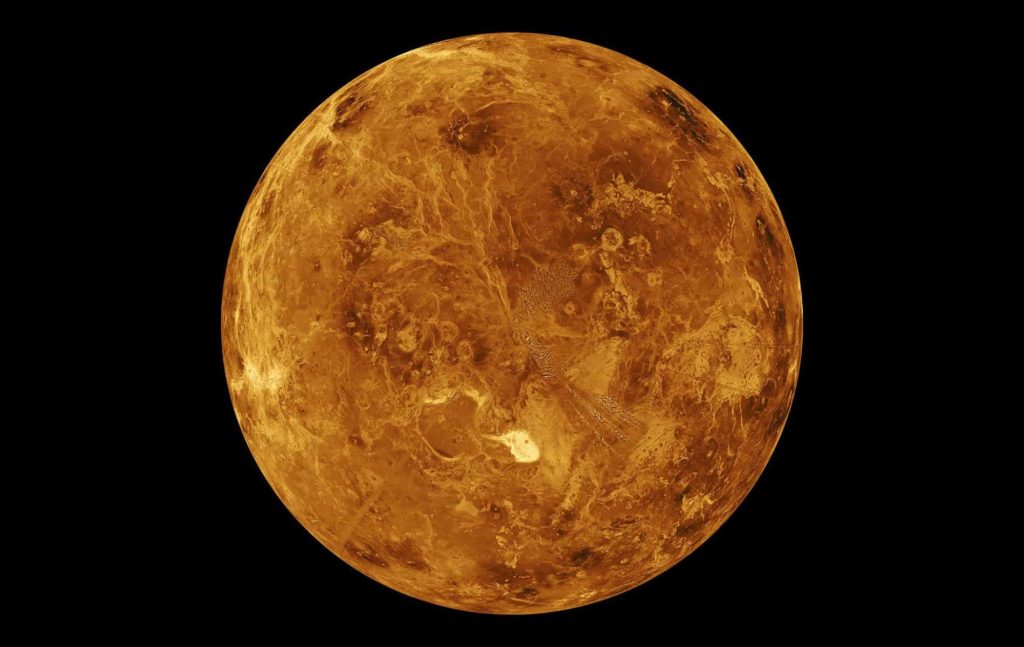A new study suggests that Earth’s “twin sister” had tectonic plates billions of years ago. This may have been very useful for microscopic life.
Venus, our closest neighbour, is known as a scorching, inhospitable world. This is because Venus is suffering from out-of-control global warming. The thick atmosphere traps all the heat, causing the surface temperature to reach 465 degrees Celsius. Not really a suitable environment for life. But researchers have now discovered that this may have been very different in past eras. Because it appears that Venus may have had tectonic plates in the past, similar to those that existed on early Earth.
Twin sisters
Venus is similar to Earth in many ways. The planet is approximately the same size and has a similar structure. But at the same time the conditions are more brutal. Not only is it very hot, but the planet is also surrounded by a layer of clouds covered in corrosive sulfuric acid. Therefore, Venus is often described as Earth’s uninhabitable twin sister. The big question is what caused the planet to take such a different direction at one time and look so different today. One theory being considered is that Venus has an “immobile crust.” This means that the surface consists of only one large panel with very little movement.
Stady
But a recent study suggests that this may not have always been this way. In the magazine Nature astronomy A group of scientists describes how they studied data on the atmosphere of Venus and used computer models. They concluded that the formation of the present atmosphere and surface pressure is only possible as a result of an early form of plate tectonics.
Tectonic plates
This is very fun. Plate tectonics is a process crucial to the emergence of life, and involves multiple continental plates pushing, pulling and sliding against each other. On Earth, this process has continued to evolve over billions of years. This led to the creation of new continents and the formation of mountains. At the same time, chemical reactions helped stabilize surface temperatures, creating an environment more suitable for life to develop.
Meanwhile on Venus
Venus currently has an abundance of nitrogen and carbon dioxide in its atmosphere. To explain this, researchers suggest that Venus must have had tectonic plates at some point, somewhere between 4.5 and 3.5 billion years ago. The paper suggests that these ancient tectonic movements were similar to those on Earth, although this occurred with only a small number of plates that did not move that far. These movements would have occurred at approximately the same period on both Earth and Venus.
comparable
This means that in the distant past Venus may have been more like Earth than previously thought. “One of the key discoveries is that Earth and Venus likely experienced a similar process of plate tectonics at some point,” researcher Matt Wheeler said. “This process played a role in creating the conditions suitable for life as we know it on Earth.”
To live
In fact, because this discovery means that there may have been life on Venus. It increases the possibility that the planet may have harbored microbial life.
transition
The study also suggests that the precise timing of plate tectonic activity on planets may be of great importance. This may also affect the development of life on those planets. “Until now, we thought of plate tectonics as something very simple: it either happens or it doesn’t, and it stays that way for the entire life of the planet,” says researcher Alexander Evans. “But we are now showing that planets may experience different tectonic states and that this is not rare. Earth may be the exception to this rule. Moreover, this means that planets can sometimes be suitable for life, and sometimes not. This may not be the case.” Also permanent.
Atmosphere
Overall, the study suggests that Venus and Earth – two planets located in the same region and having the same size, mass, density and volume – were at one time not just twin sisters, but perhaps identical twins. The study thus raises interesting questions about planetary evolution and the history of our solar system. This is done by studying the atmosphere of Venus only. “Until now, we’ve mainly looked at planetary surfaces to unravel their history,” Evans says. “What makes this research really interesting is that it suggests that we may be able to better use planetary atmospheres to understand their very ancient history, even if that history is not well preserved on the surface.”
Within a few years, the da Vinci mission, which will measure gases in the atmosphere of Venus, will help confirm the results of this research. In the meantime, the researchers plan to delve deeper into an important question raised by the study: What happened to plate tectonics on Venus? The team suspects that the planet eventually became too hot and its atmosphere too dense, drying up elements necessary for tectonic movement. “Venus became stressed in some way, which slowed the process,” says researcher Daniel Ibarra. According to the researchers, the specific details of how this happened on Venus could have important implications for our planet. “This will be an important next step in understanding Venus, its history, and what that could mean for Earth’s future,” Wheeler said. “The big question is: What conditions could cause Earth to follow a Venus-like path, and what conditions could keep our planet habitable?”

“Coffee buff. Twitter fanatic. Tv practitioner. Social media advocate. Pop culture ninja.”









More Stories
Scientists produce huge amounts of carbon dioxide emissions through their trips to international conferences
A unique image of atoms behaving like quantum waves
Dutch IT Channel – IT systems will provide ‘tax authorities’ with more room for changes from 2027′